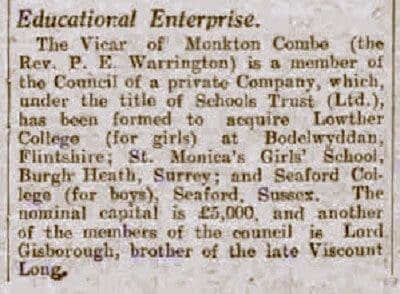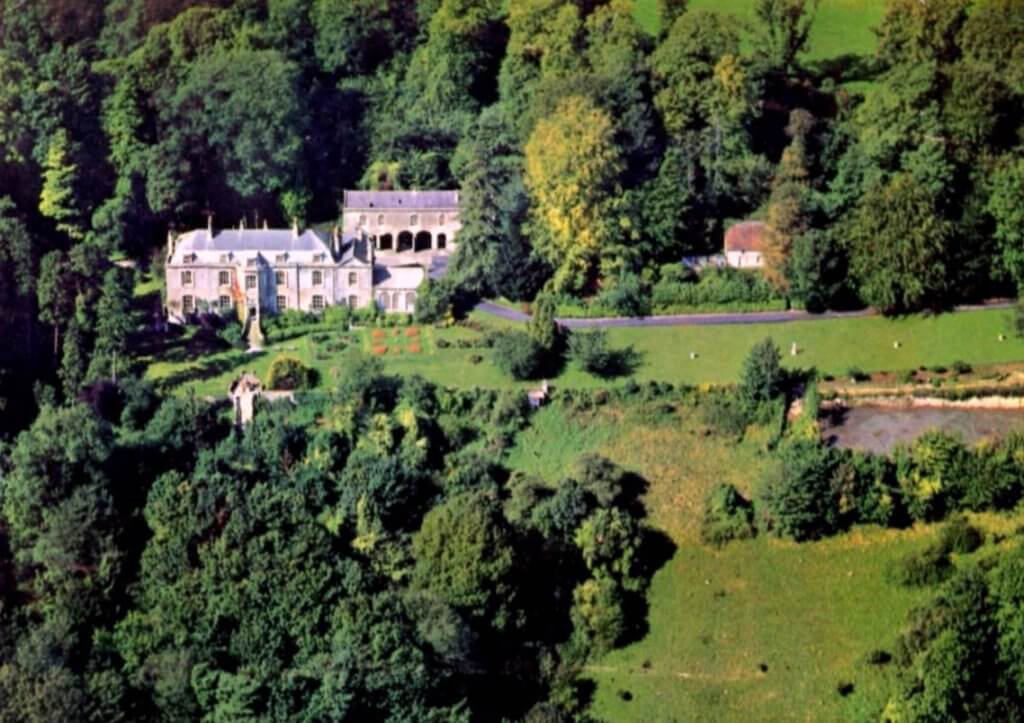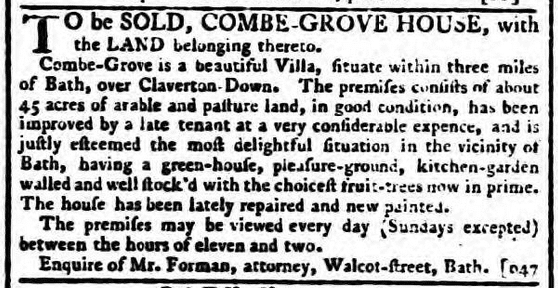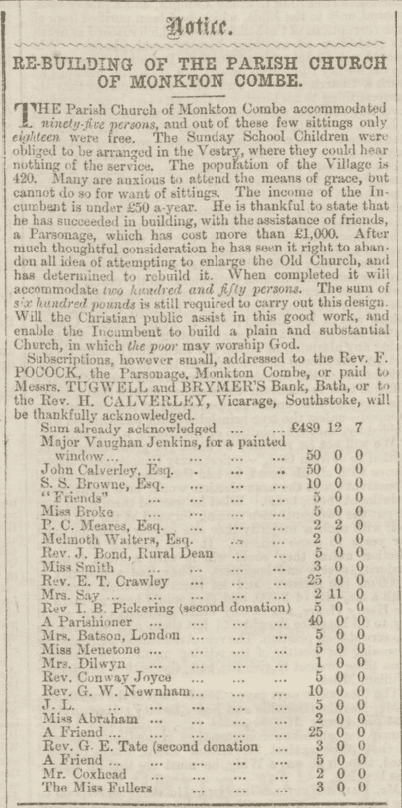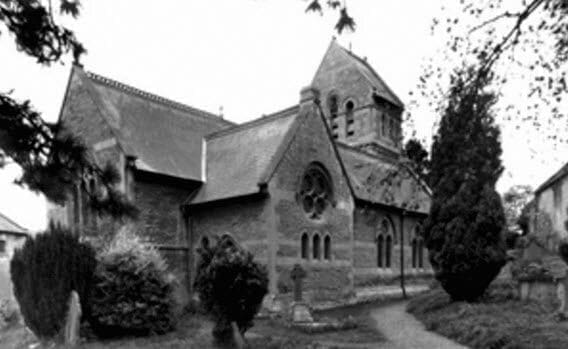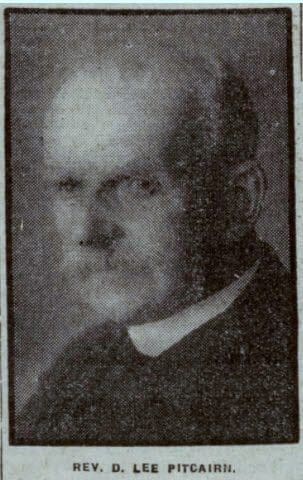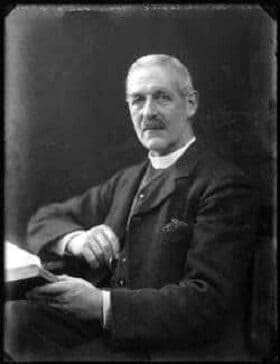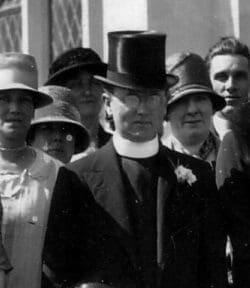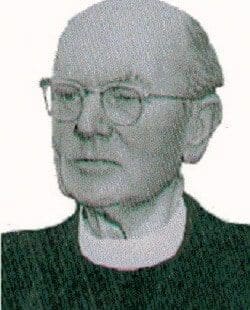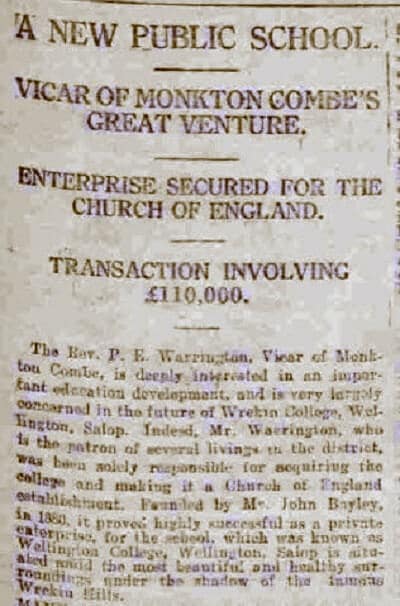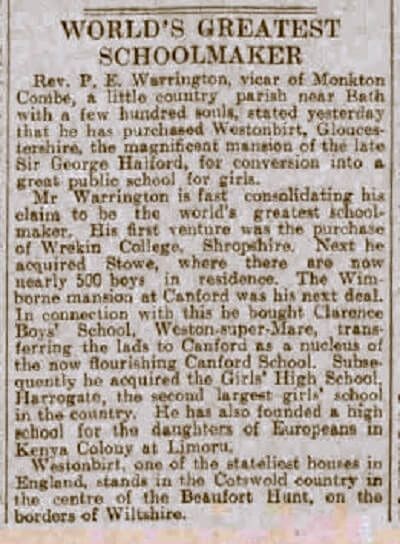Monkton Combe
Monkton Combe
Combe Down as a settlement did not exist, it was was uninhabited, exposed countryside before Ralph Allen.
We know there was Roman occupation on Combe Down, as a Roman Villa was found below Belmont Road in 1852. On a stone coffin lid that was found there was the inscription:
"PRO SALVTE IMP CES M AVR ANTONINI PII FELICIS INVICTI AVG NAEVIVS AVG LIB ADIVT PROC PRINCIPIA RVINA OPRESS A SOLO RESTITVIT".
This has been translated as:
"For the health of Imperator Caesar Marcus Aurelius Antoninus Pius Felix Invictus Augustus, Naevius the imperial freedman, helped to restore from its foundations the procurator's headquarters which had broken down in ruins."
It is thought to date from AD 212 – 222 or 218 – 222 in the reign of either the emperor Caracalla who ruled from January 212 until April 217, or emperor Elagabalus who ruled from June 218 to March 222. Whilst it is unproven, it’s possible that the Romans had open cast quarries too.
Another notable sign of occupation is the Wansdyke (Wodnes Dic). This is a linear boundary, a 2 – 3 metre high bank, above a 2 – 3 metre ditch, that is 4 – 5 metres wide and about 50 miles long, running from Bristol to Berkshire.
It is thought to be prehistoric in origin but modified during the early medieval period (5th – 6th century), when it is believed to have been used as a frontier or boundary between Wessex and Mercia. The West Wansdyke runs from Monkton Combe via Horsecombe and past the Cross Keys, then over Odd Down to the ancient hill fort of Maes Knoll at Dundry Down, South of Bristol.
Monkton Combe was here well before Combe Down Village. It appears in the Domesday Book as “Cume”. Combe is related to the Gaelic Cwm and means a short valley or hollow on a hillside or coastline.
It had: 20 households, 9 geld units, and a value to the lord in 1086 of £8, 6 villagers, 8 smallholders, 6 slaves, 8 ploughlands, 3 lord’s plough teams, 5 men’s plough teams, 6.0 lord’s lands, 32 acres of meadow and 1 * 1 leagues of woodland, 2 mills, value 0.67, 1 cob, 12 pigs, 72 sheep. It belonged to the Bath Abbey.[1]
The down of Combe gets its name from the village of Combe, hence Combe Down. Combe means deep hollow or valley, especially on flank of a hill, probably a British word, from Celtic base – compare the Welsh cwm with the same sense. Down is from the Middle English dūn meaning a hill and then elevated rolling grassland from about 1300. Because it was owned by Bath Abbey (founded in 757) [2] it became known as ‘Monnken Combe’ [3] and then with the Combe either before or after Moncton, Monckton or Monkton. It was probably given to Bath Priory by King Edgar who is said to have brought the Benedictines to Bath Abbey [4]. According to Rev. D. Lee Pitcairn and Rev. Alfred Richardson no monastery existed in Monkton, it was farmed to supply food to the Abbey.[5]
The area of Combe Down Village was a part of Monkton Combe parish until 1839.
There is some evidence of medieval field systems on Combe Down and in Monkton Combe [6], but it was not heavily occupied and was described by John Leland in his visit in the 16th century [7]:
From Farley I ridde a mile of by woddy ground to a graung great and welle buildid, that longid to Henton-priorie of Chartusians. This priory stondith not far of from this graunge on the brow of an hille abouth a quarter of a mile from the farther ripe of Frome, and not far from this place Frome goith ynto Avon. I rodde by the space of a mile or more by woddes and mountaine grounde to a place, where I saw a rude stone waulle hard on the right hond by a great lenghte as it had beene a park waulle. One sins told me that Henton b priory first stode there, if it be so it is the lordship of Hethorpe that was gyven to them for their first habitation. And about a mile farther I cam to a village, 6 and passid over a ston bridge where ranne a litle broke there they caullid Mitford-water. This brooke risith in the rootes of Mendip-hilles a 7 miles or more by West South West from this bridge, and goith about a mile lower into Avon. From this bridge to Bath 2 good miles al by mountayne ground and quarre, and litle wood in syte. About a mile from Bath I left the way that ledith to Bristow for them that use from Saresbyri to Bristow.

In 1791 Collinson said about Monkton Combe [8]:
“THIS place is generally called Monkton-Combe, the adjunct being placed first; but its simple proper name is Combe, the other having been added to signify its belonging to the monks of Bath, and to distinguish it from other places of a similar appellation. It is situated three miles South from Bath, and bounded, by a rivulet from Midford, which divides it from Limpley-Stoke in the county of Wilts. The number of houses is fifty-three, and of inhabitants about two hundred and eighty. The village stands near the bottom of the Southern declivity of a hill, called after its name Combe-down, which rises with a steep ascent to the North and cast. On the South side of the street is a narrow picturesque vale, watered by the stream above- mentioned, which after turning a corn-mill empties itself into the Avon. The opposite hill, which rises near five hundred feet from the bottom of the vale, is divided into fine inclosures, patched with beautiful hanging coppice woods, and highly cultivated. To the right as you enter the village, and about three hundred feet above the street, is an elegant mansion called Combe-Grove, belonging to Mrs. Simpson of Bath. This house stands on a natural terrace, a little below the Southern ridge of Combe-down hill. The back ground is a thick wood, which forms a small segment of a circle, in the centre of which the house is erected. The prospect from this spot, over the vale and the slope of the opposite range of hills, is very beautiful;”
However, he then went on to say:
“……….The manor of Combe is thus described in the Norman survey, among the estates of the church of Bath: "The church itself holds Cume. In the time of King Edward it gelded for "nine hides". The arable is eight carucates. Thereof in demesne are six hides, and there "are three carucates, and six servants, and six villanes, and eight cottagers, with five ploughs". There are two mills of thirteen shillings and sixpence rent, and "thirty-two acres of meadow, and one mile of coppice wood in length and breadth." It was worth seven pounds, now eight pounds." In 1293, the temporalities of the abbey here were valued at 4.1.b After the dissolution of monasteries, king Henry VIII by letters patent bearing date March 16, 1542, granted the manor of Combe to Humphrey Colles[9] who soon after sold it to Matthew Colthurst. Reverting to the crown, it was granted, 6 Eliz. to John Robinson, of Gravesend in Kent, esq; whose descendant John Robinson, esq; of Durston-hall in the county of Suffolk, sold it in the year 1706 to Mr. Francis Poole of this place, who bequeathed it to his son-in-law Thomas Shute, gent. In this family it continued till about the year 1772, when Mr. Thomas Whittenton purchased it of his brother-in-law Mr. Thomas Shute, and sold it immediately after to the rev. Richard Graves, A. M. rector of Claverton, who is the present owner.”
The ownership list after “dissolution of the monasteries” has been repeated numerous times since [10], though Pitcairn & Richardson say it was owned by a Thomas Poole (who was Francis Poole’s son) rather than Francis Poole:
“Combe was the property of Bath Abbey until the Dissolution, passing into the hands of Humfrey Colles in 1542 and then to Matthew Colthurst. The manor reverted to the crown until 1564 when Eliz ll granted it to John Robinson of Gravesend. His descendant John Robinson of Durston Hall Suffolk sold it in 1706 to Thomas Poole of Combe. He bequeathed it to his son-in-law Thomas Shute and in 1722 it was sold to Thomas Shute's brother-in-law Thomas Whittenden who immediately sold it to Rev Richard Graves, Rector of Claverton.”
The ownership of the manor by Richard Graves is repeated in the Dictionary of National Biography [11]:
“Through his preferments and scholars he gradually acquired considerable means, and among his purchases was the manor of Combe in Combe Monckton……”
However, a deed amongst the Vaughan-Jenkins family papers in the Bath Record Office dated 25th October 1706 actually shows that there was an assignment from: John Robinson Esquire of Denston Hall, Suffolk, son & heir of Sir John Robinson of Denston Hall, knight, deceased and Humphrey Saunders, gentleman, of Saint Margaret’s, Westminster, Middlesex and Francis Poole, yeoman, Thomas Shute, yeoman, both of Monkton Combe, William Wiltshire, yeoman, of Lyncombe & Widcombe, John Ward, yeoman, John Fisher, broadweaver, William Tibbott, yeoman, James Gracey, yeoman, William Merchant, broadweaver, Joseph Silcock, broadweaver, Mary & Ann Deverell, spinsters, Richard Silcock, broadweaver and Francis Charmbury, yeoman late tenants of the Manor of Monkton Combe to Andrew Innys, gentleman of Clements Inn, Middlesex and Martin Innys, gentleman, his son of the remainder of a 500 year lease of the Lordship and Manor of Monkton Combe for a consideration of £726 5s. [12]
John Robinson Esquire (1680 – 1734) of Denston Hall, Suffolk, son & heir of Sir John Robinson (1654 – 1704) of Denston Hall was indeed a descendant of John Robinson of Gravesend (1581-1674) [13] who was the son of John Robinson of London (1545 – 1609) who owned the manors of Monkton Combe and Wedmore. [14]
Other than that he was, obviously, a lawyer, all I have established about Andrew Innys is that on 29th April 1669 at Bath Abbey, an Andrew Innys (b.1645) married Joane Randall (b.1648), who was the daughter of Robert Randall, who was the son of Matthew Randall (1571 – 1641), who was a Mayor of Bath.
Here we should differentiate between a feudal ‘Lordship and Manor’ and a house called a manor. Lord Denning described the feudal manor thus [15]:
“In mediaeval times the manor was the nucleus of English rural life. It was an administrative unit of an extensive area of land. The whole of it was owned originally by the lord of the manor. He lived in the big house called the manor house. Attached to it were many acres of grassland and woodlands called the park. These were the “demesne lands” which were for the personal use of the lord of the manor. Dotted all round were the enclosed homes and land occupied by the “tenants of the manor”.
The manor of Combe referred to as being granted by Henry VIII is the feudal manor derived from the crown which, even in the 18th and 19th centuries, would have had value. Lordship of a manor carried rights over land within the manor, even land that was in the hands of tenants, such as the right to:
- hunt wild animals on the demesne and wastes of the manor.
- require tenants to grind their grain at the Lord’s mill for payment.
- the minerals under copyhold land.
- the unenclosed manorial waste or common land which remained in its semi-natural state and not assigned to any individual. Uses such as pasture, turbary (cutting turf or peat) and estovers (use of wood) were allowed on manorial waste but other uses incurred payment of rent to the Lord.
- wild fish in rivers and lakes and payment from people fishing.
- Woodland where there was a distinction between timber (wood generally over 24″ round) and underwood (the scrub and bushes). Tenants usually had the right to take underwood growing on their lands but lords retained the right to timber growing on copyhold land, as well as the rights to woodland.
So, it seems Andrew Innys bought the feudal manor in 1706. What happened to it after that I have not established.
The feudal manor did, of course, have a manor house. The original manor was likely to have been what is now known as Monk’s Retreat. [16] It is possible Francis or Thomas Poole bought the feudal manor from Andrew Innys. If it was Thomas (rather than Francis) Poole, then his will [17] in 1765 mentions Shute House which Pitcairn & Richardson suggest [18] became The Manor House at Monkton Combe.
It is also clear, from the same Vaughan-Jenkins papers at Bath Record Office, that John Robinson sold other property to Thomas Shute on 14th / 15th June 1706 namely:
"a messuage, 2 orchards, 2 gardens, another messuage with a shop orchard and garden and several plots of ground called the Backside, Elm Mead adjoining the malthouse, Pittlands, Hither Binmeade, Father Binmeade, The Croft, Townesend Close, Gidmeade, Tucking Mill Leaze with decayed house formerly a fulling mill, Motley Hill, New Leaze, The Horsecombes, Charmeade, Millham, Hurlihgham and arable lands in East and West fields for a consideration of £388 10s".[19]
On the same date he sold to Francis Poole:
a messuage with backside, stable, barn, oxhouse and wainhouse, 2 orchards, 2 gardens, a water grist mill and a cottage with several plots of ground called the Barne with orchard adjoining the Croft, The Ham, Charmeade, Didfords, Grove Forest, The Horsecombes, Damsk aly, Croft Acre, Binmeade and arable lands in East and West fields for a consideration of £338.[20]
So, before Ralph Allen’s arrival Monkton Combe was an agricultural area with some important local houses whilst Combe Down itself had some quarries and probably some grazing.
We must not forget Prior Park. There is a brief history here.
Waterhouse
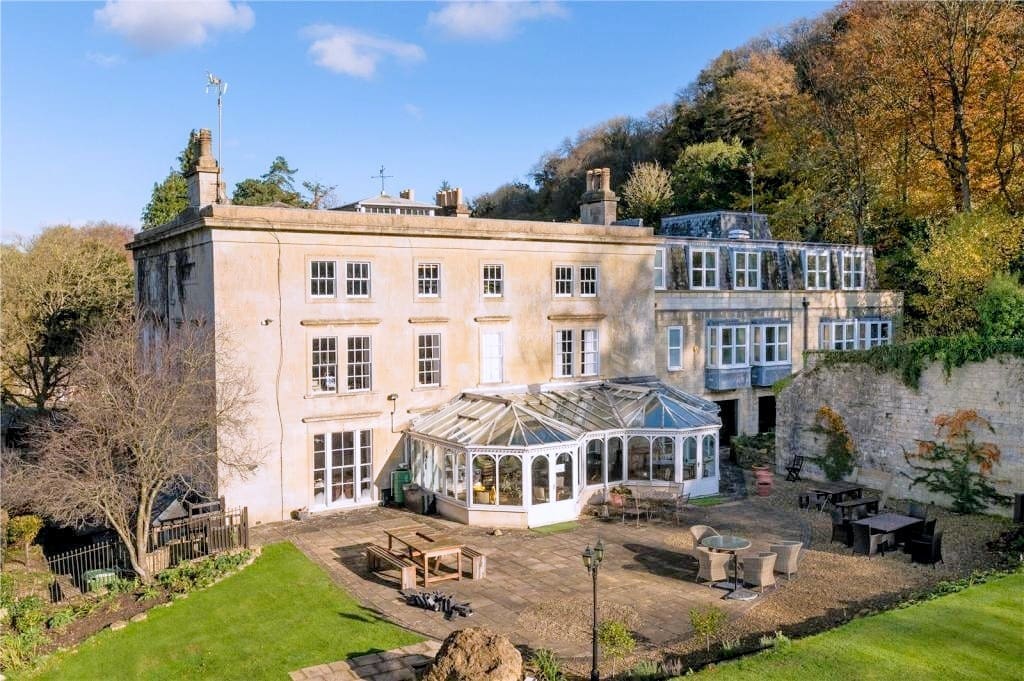

Strictly speaking Waterhouse is a part of Limpley Stoke, but it is so close to Monkton Combe that it is often thought of as a part of it.
By 1500, a fulling mill was providing employment at Limpley Stoke and weavers’ cottages were built to accommodate the textile workers.
The village had been included in the dowry of Frances Walsingham (1567-1633) on her marriage to Sir Philip Sydney (1554-1586) in 1584. He later died in battle and she then married Robert Devereux (1565-1601) 2nd Earl of Essex, KG PC in 1590.
After his execution for treason she married Richard Burke (1572-1635) 4th Earl of Clanricarde in 1603. By 1610 they had debts and sold the villages of Turleigh, Limpley Stoke and Midford to Richard Dickes (1563-1639), a wealthy clothier, in 1615.
Richard Dickes married Jane Longe (1575-1646), who came from a wealthy Wiltshire family and three of their sons shared the village, with George Dickes (1628-1669) inheriting the major part based at Waterhouse.
Waterhouse was built 1632 as a family home by the Dickes family, It descended through the Dickes family until Ann Dickes (1685-1740) married Henry Fisher (1685-1739).
The Fishers were brewers with premises near to Limpley Stoke Manor. Then it descended to Henry Fisher (1721-1778) to George Dikes Fisher (1759-1834).
George Dikes Fisher was the brother of Margaretta Sally Fisher (1764-1812) who married Richard Shute (1753-1819) and whose children Mary Susannah Shute (1789-1812) and Margaretta Sally Shute (1790-1812) and sister Hester Fisher (1767-1812) all drowned in a boating accident at Chepstow and are commemorated in Monkton Combe church graveyard.
Waterhose was sold when George Dikes Fisher died.
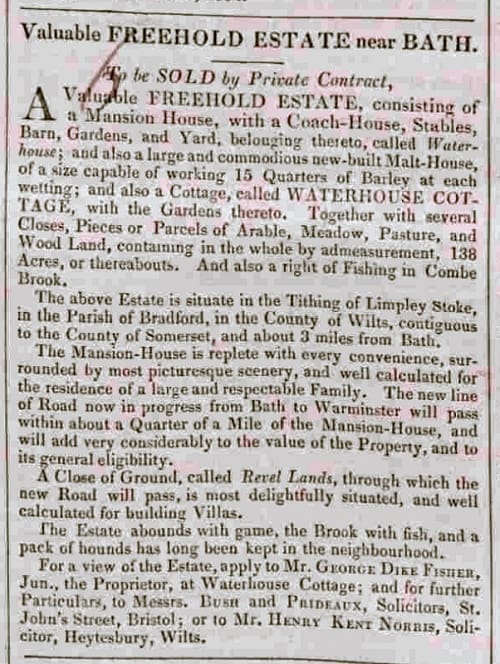
The purchaser was a Maj Henry Toogood Davis (1791-1859), who is noted in directories and The Bath Chronicle. As the cuttings show he had financial difficulties and in 1848 Capt Desaguliers West (1814-1875) bought Waterhouse.
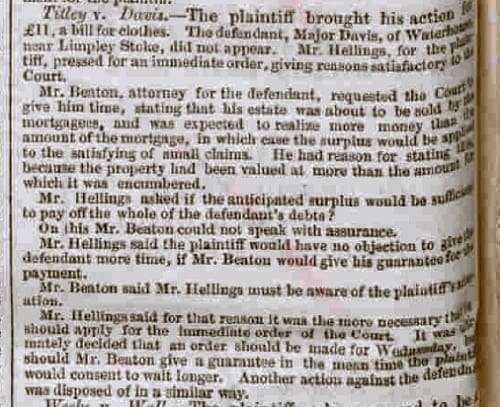


In 1858 Waterhouse was again put up for sale but Desaguliers West was still in residence until at least 1863, as evidenced by an article in the Bath Chronicle and Weekly Gazette, Thursday 3 September 1863.
His wife Eleanor Banford Kirkpatrick (1820-1860) had died at Waterhouse and in 1864 it was put up for rent. In 1865 Desaguliers West married Eliza Harriet Pattle (1828-1883) and moved up to Kettering.

Waterhouse was rented to a George Levy in 1866-67 and from 1871 to 1876 to Philip Charles Sheppard (1812-1878), his wife Mary Markham (1812-1885) and family.
Philip’s family were woollen merchants and Lords of the Manors of Minchinhampton and Avening.
Mary’s parents were Osborne Markham MP (1769-1827), the youngest son of Dr William Markham (1719-1807), who was Archbishop of York and Lady Mary Thynne (1778-1814), a younger daughter of Thomas Thynne (1734-1796) 1st Marquess of Bath, KG PC.
Philip and Mary had a major impact on education in Bath.
In 1845 they had moved to Bathampton Manor, the property of Maj Ralph Shuttleworth Allen (1817-1887). In 1848 Philip Charles Sheppard became a magistrate and began to involve himself in various other organisations.
In 1853 Sheppard started to interest himself in the education of Bath’s youth. This commenced with the opening of the Bath Proprietary College in the former hotel building now known as the Holburne Museum. Sheppard was a member of the School Council. Sydney College as it came to be called, was a distinguished school in its day, but there was disagreement between two factions on the Council on whether the School should provide a Classical or General education, leading to a rift. The break-away faction who preferred the Classical approach was led by Sheppard. In 1858 they set up a rival school in the Circus, which they named the Somersetshire College.
The 1855 Criminal Justice Act allowed Magistrates to sentence children under 16 to at least 14 days imprisonment or to a period of 2-5 years in a Reform School. Each county was required to have provision under the act and many created new purpose-built schools. In Bath a committee, mainly clergy, was convened to look at setting up a reformatory for girls. Premises were eventually identified at Limpley Stoke Manor House.
On 9 January 1861 the Reformatory opened its doors. The task of managing it was undertaken by Sheppard as Hon Secretary, with a matron undertaking the day to day management. However after an unsatisfactory report from the inspectors, Sheppard brought in his wife Mary to undertake the hands on management, resulting in an immediate improvement in the inspection reports.
Sheppard was also to perform a similar role in Bath for boys. The Somerset Industrial School for Boys (later City of Bath Technical School) opened in 1866 at Devonshire Buildings on Wellsway but in 1880 it moved to the Lower Bristol Road in Twerton.
Desaguliers West died in 1875 and in 1876 Waterhouse was purchased by Johnson Frederick Hayward (1822-1912).
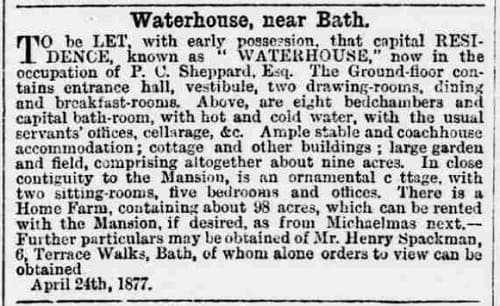


Johnson Frederick Hayward (1822-1912) went to Adelaide, South Australia in 1846. He arrived to start sheep farming on his own account. In 1850 he set up in partnership, his capital being a horse called Nimrod, £100 in cash and experience.
He returned to England in 1864 a wealthy man, purchased an estate at Limpley Stoke which he named Aroona, after his old South Australian station, and lived there until his death. He bought Brett Farm and Waterhouse in 1876 at an auction sale in Bath for £6,640 l2s 7d plus timber at valuation which took the price up to £7,000.
His father was Dr Joakim Cooper Hayward (1782-1864) and his mother Anna Maria Catherina Wiltens Andree (1793-1857), the sister of Magdelena Gurtruyda Johanna Wiltens Andree (1796-1861) who married Lt Edward Teast Wylde RN (1792-1860) who lived at Claremont House on Church Road.
From around 1880 the Harrison sisters leased Waterhouse and lived there for 40-50 years. Helen Eliza Harrison (1837-1924), Rose Harrison (1841-1887), Jessie Harrison (1842-1929), Edith Harrison (18454-1925) and Evelyn Sarah Harrison (1857-1920) appear in censuses at Waterhouse, together with their brother Harold Bertram Harrison (1856-1924), and nieces Eva Scott (1871-1941) – who, later, lived at Lodge Style – and Nora Scott (1872-1907).
When Ellen Margaret Litchfield (1844-1925), Johnson Frederick Hayward’s wife, died Rev Percy Warrington, purchased the house in 1926 and converted it into a Care Home in 1946 after breaking up the estate.
Founder of M&S Simon Marks (1888-1964) 1st Baron Marks and his wife and daughter were amongst those who found a home at Waterhouse during the war.

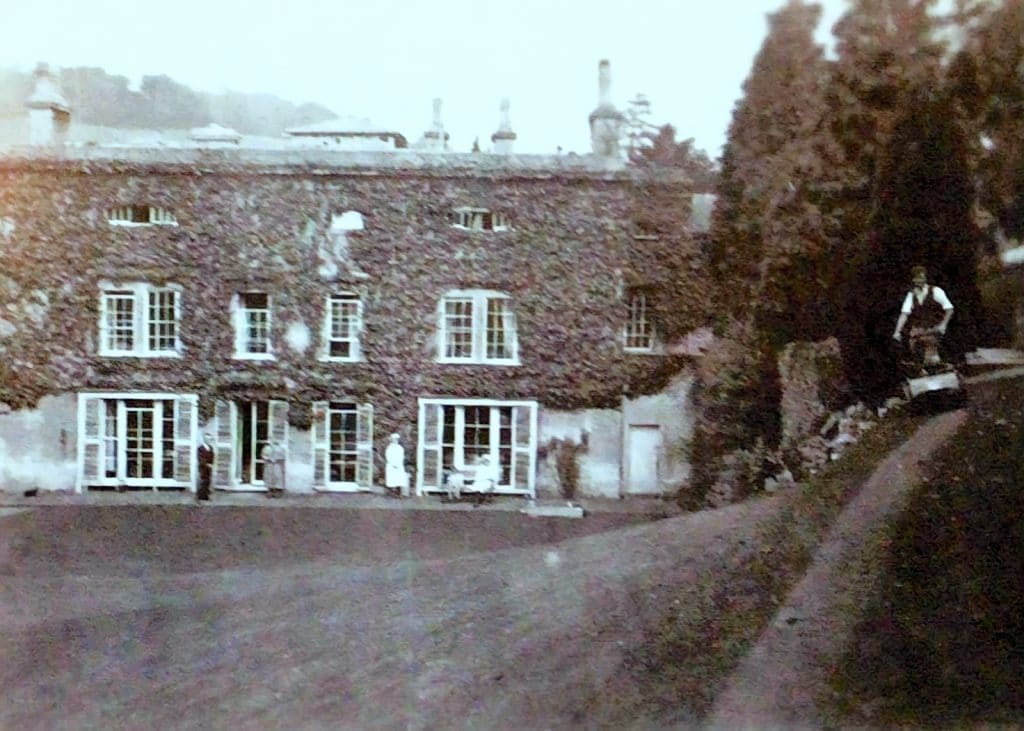
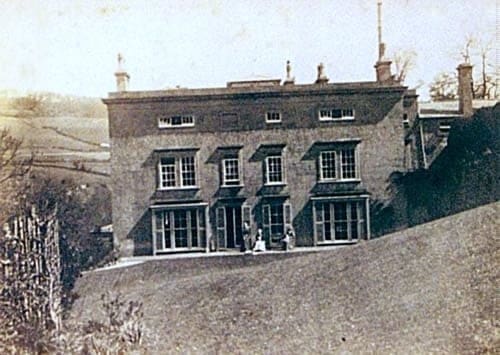
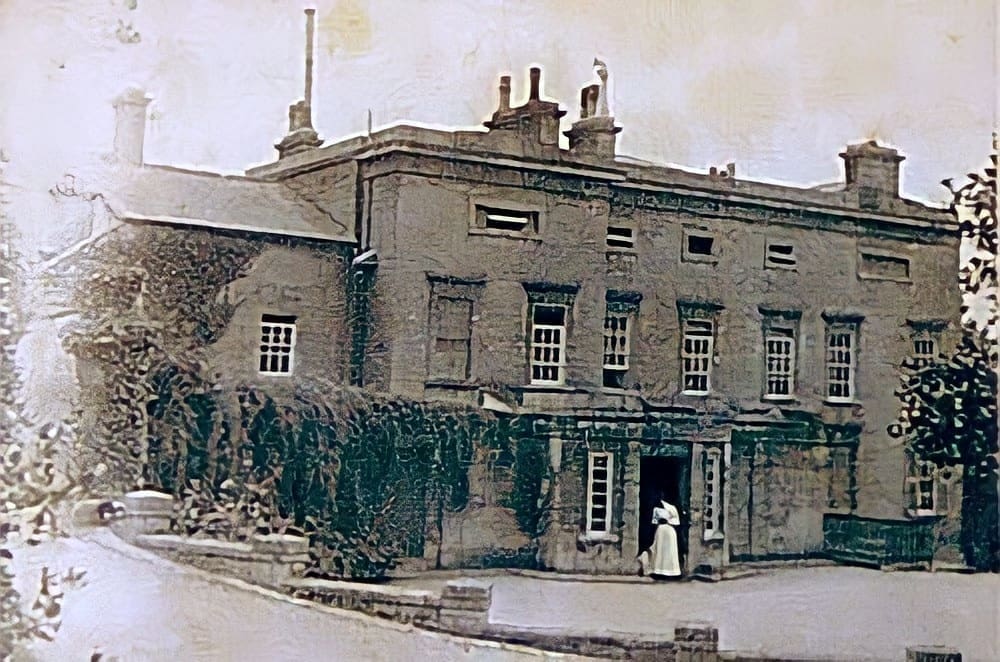

In 2009 The Wilsher Trust bought Waterhouse. In March 2021 it was up for sale.

Combe Grove Manor
Combe Grove Manor
Combe Grove Manor has existed from about 1700, though it is possible that there was a house on the site before that. Pitcairn & Richardson say about Combe Grove Manor [21]:
“….The House which commands fine views to the South was built about the year 1707……..Combe Grove was purchased in 1783 by Mr William Davis, who three years later married Elizabeth Jenkyns, daughter and heiress of William Jenkyns, lord of the manor of Priston and at his death he bequeathed it with the Priston estate to his nephew William Vaughan…………….The name and armorial bearings of Vaughan and Jenkins were subsequently combined by Royal license in 1814.”
Before William Davies bought Combe Grove Manor it went through a number of hands as the same Vaughan-Jenkins papers at Bath Record Office make clear.
The deed selling Combe Grove Manor to William Davies of 2nd February 1786 tells us that:
“…formerly called The Grove, Grove Hill, Gruddy Bottom, Pittlands Tyning, Woodwards Tyning or Morris’s, Sheppard’s Piece, Quarry Sands, 2 messuages a barn and street adjoining, The Tyning with oxhouse and stable, Keymead, Shute Croft Tyning, a tyning at Woodwards Corner adjoining Claverton Gate, Woodwards and Crab Tree Tyning but now known as Combe Grove House…”[22]
was sold to William Davies (abt 1725 – abt 1798). This allows us, assuming that The Grove is the area where the house is located, to piece together who owned it previously, even if not all the land mentioned is exactly the same.
Thus, on 14th and 15th June 1706 John Robinson Esquire of Denston Hall, Suffolk sold for £299 10s, by lease and release to William Tibbott, yeoman:
“… a messuage with yard, garden 2 orchards and lands called the Grove with orchard adjoining.”[23]
On 26th August 1706 William Tibbot and Edward Bird of Bristol, mariner sold it on a 1,000 year lease, for £400 by bargain and sale to Johanna Jefferies of Bath, widow and security of title was granted on 11th May 1710 for £220. [24]
On 30th September 1712 Johanna Jefferies and William Tibbot sold a share to William Robbins for £100. [25]
On 31st March 1716 William Tibbot and William Robbins made an assignment, presumably of their share to Francis Charmbury, yeoman of Monkton Combe for £140. [26]
On 18th April 1720 William Tibbot, Francis Charmbury made an assignment with bond to Richard Clement, yeoman of Stowford for £220.
On 22nd March 1725 William Tibbot, Richard Clement and Samuel Clement of yeoman of Southstoke, made an assignment to Samuel Charmbury yeoman of Monkton Combe and Richard Dike, gentleman, of Waterhouse for £500 and on 23rd and 24th March 1725 William Tibbott leased and released it to Samuel Charmbury for £500. He in turn seems to have taken a mortgage of £300 from Thomas Dicke for this. [27]
On 7th September 1733 Samuel Charmbury and Thomas Dicke assigned it, for £337 10s to William Battell of Foscote, Wiltshire, clerk with Dorothy Dame Hesilrige of Bath, widow, as trustee. [28]
In August 1743 there was a bargain and sale and mortgage on the marriage of the Reverend William Battell to Elizabeth Davies with William Battell placing it in trust for his wife with John Davies, gentleman (and brother of Elizabeth Davies) of the New House, Herefordshire, the Reverend James Poole of Stretton Grantham, Hereforshire and the Reverend John Davies of Much Cowan, Herefordshire.
On 1st November 1770 there was a bargain and sale from William Battell, of the Hay in the county of Brecon, only son and heir of William Battell, of the parish of Monkton Combe, to Christopher Hull, gentleman, of Hare Court in the Inner Temple and then on 12th and 13th April 1771 a lease and release, for £1,590, by William Battell to Charles Simpson, gentleman of Bath. [29]
Combe Grove Manor was for lease in 1780 and for sale in 1781 and remained unsold for some time, appearing regularly in the Bath Chronicle.
On 26th March 1782 there was a lease for 6 years for £97 from Ann Simpson of Bath, widow to William Davies Esquire of Priston, Somerset of a messuage known as Combe Grove and…..
On 21st and 22nd November 1783 there was a conveyance agreement with declaration, for £1,900 consideration and £87 rent between Ann Simpson and Richard and William Turner, both merchants of Bristol for Combe Grove and several plots of ground.
On 2nd February 1786 there was a conveyance between Charles Simpson Esquire of Madras, India eldest son and heir of Charles Simpson Esquire of Bath, deceased, Ann Simpson and William Davies of Combe Grove for the conveyance of the house and lands for £1,900. [30]
It’s a complicated story and is in fact more complex as there are a range of mortgages and other documents not mentioned above.
However, in simple terms, Combe Grove Manor was owned in about 1700 by the Robinsons of Denston Hall, Suffolk. Clearly when Sir John Robinson (1654 – 1704) died his son determined to sell off some properties. How long they had the land in Monkton I have not established.
Over the next 30 years it was sold and resold until the Rev William Batell (abt 1692 – 1750) took possession in 1733. He was first married to Dorothy Hesilrige (d.1741) a daughter of Sir Robert Hesilrige, 5th Baronet, of Noseley Hall, Leicester whose father had married Dorothy Greville, sister of Robert Greville (1607 – 1643), 2nd Baron Brooke. The Reverend Battell came from a clerical family. His grandfather, father, son (by Elizabeth Davies his second wife), two uncles and a cousin were all parsons. The Reverend Battell was curate of Combe Hay and then rector of both Camerton and Kilve from 1735/6 to his death.
During his ownership of Combe Grove John Wesley (1703 – 1791), co founder of the Methodist movement, preached there several times [31].
William Davies (abt 1725 – abt 1798) took possession in 1786 and continued acquiring land in Monkton Combe. His death at Combe Grove is mentioned in the Bath Chronicle of Thursday 6th September 1798, as are the facts that he was made a Sheriff of Somersetshire in the edition of Thursday 19th November 1795, a governor of Bath General Hospital in the edition of Thursday 9th May 1793 and that he had made his payment for his game duty certificate in the edition of Thursday 11th October 1787.
In his will [32] William Davies leaves:
“…my Capital Mansion House, Farm and Lands called Coombe Grove situate in the Parish of Monkton Coombe in the said County of Somerset”
to his wife for the term of her life and then to his nephew William Vaughan (abt 1752 – 1818) the son of his sister Elizabeth [33]. In 1811 William Vaughan married Caroline Elizabeth Golding (1791 – 1857). In 1814 William Vaughan was granted a royal license to change his name to Vaughan-Jenkins. After he died his wife remarried to Humphrey May Freestun (1790 – 1863) who had served in the Royal Navy reaching the rank of Commander.
The Vaughan-Jenkins family owned Combe Grove Manor until 1968 rarely living in the house but letting it to tenants. They also owned Priston Manor as William Davies had married Elizabeth Jenkyns, whose father owned Priston Manor having bought it in about 1756. [34]
One of the tenants, from 1929 – 1932, paying about £250 pa, was Lady Constance Mary Lascelles, Lady Wenlock (1852-1932).
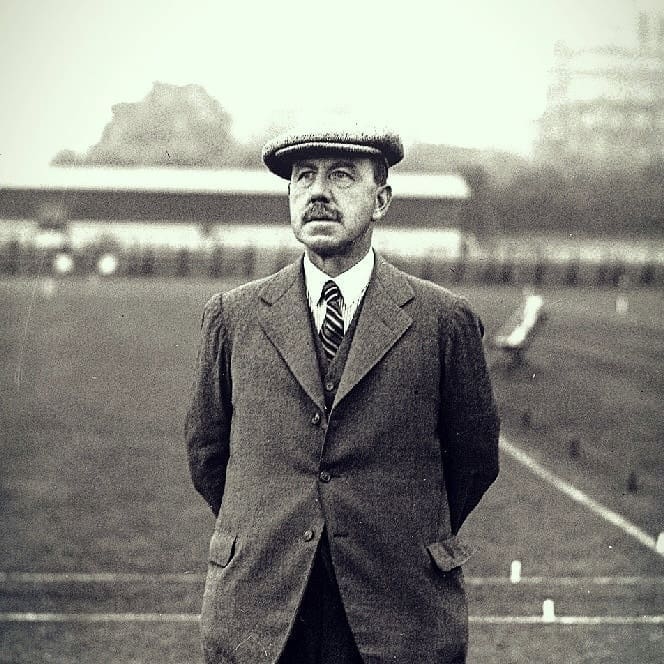
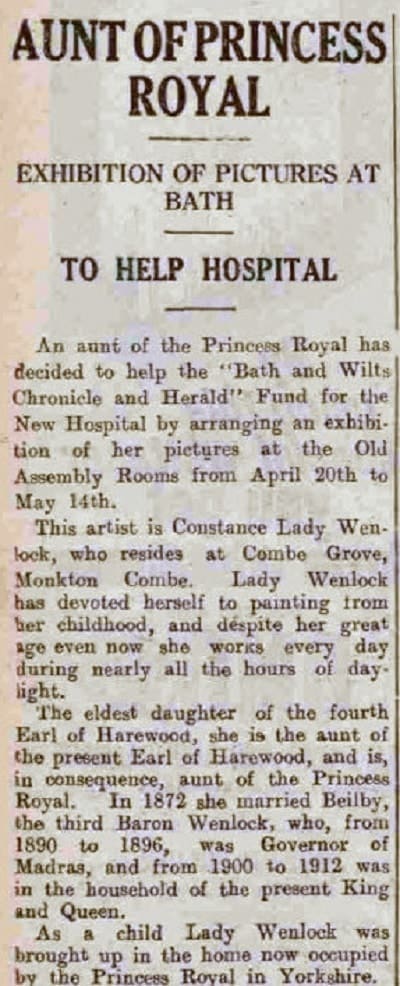
St. Michael and All Angels Church
St. Michael and All Angels Church
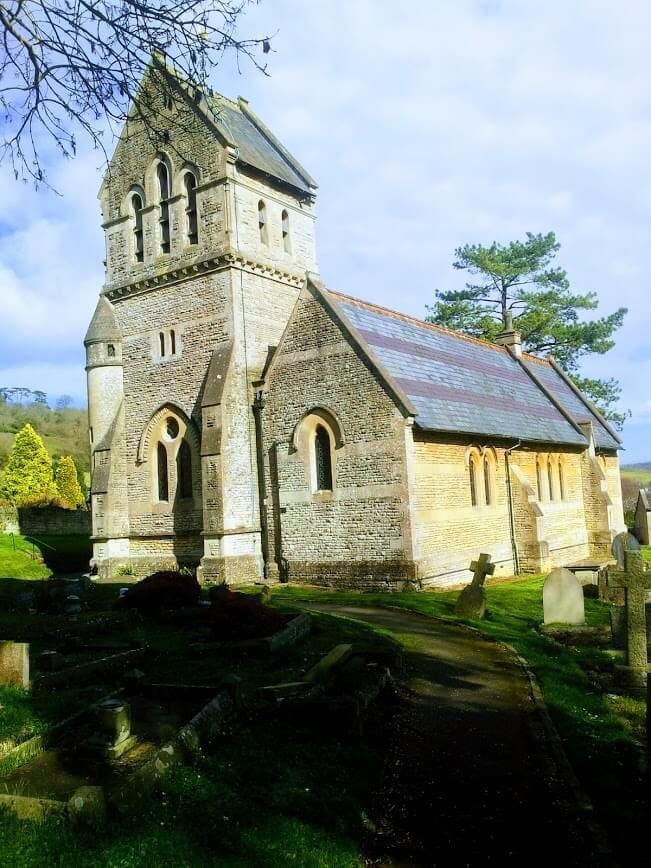
St. Michael and All Angels Church is probably the longest occupied site in Monkton Combe. Collinson in 1791 says:
“The church is a small structure, fifty feet in length, and sixteen in breadth, covered with tiles; at the West end, in a little open stone turret, hang two small bells. It is dedicated to St. Michael.”[35]
This church was replaced in 1814, but when the Reverend Francis Pocock (1829 – 1919), who also founded Monkton Combe school, arrived, in 1863, he soon determined that the replacement was too small and to build a larger church.
He launched a rebuilding fund that soon had people arranging lectures, [36] bazaars [37] and other events.
Tenders to build the church were requested in 1864 [38] and it was opened on Tuesday 4th July 1865 with £350 still to be subscribed. [39]
The total cost was £1,533 [40] and the architect was Charles Edmund Giles (1822 – 1881) of Frome. On 5th July 1868 an anniversary service was held and a sale of work was arranged after it to help pay off the debt of £250 on the new school house. [41]
In 1880 – 1882 a new North aisle was added, designed by Edwin Henry Lingen Barker (1838-1917) of Hereford [42] In 1885 £350 was spent on replacing the old organ with a new one from Henry Jones & Sons. [43]
In 1902 proposals were made to enlarge the burial ground, as Holy Trinity on Combe Down had never had one. [44]
By 1904 land had been purchased to extend the graveyard in Monkton Combe. [45] Eight bells by John Taylor & Co were added to the tower at St. Michael in 1927. [46]
Rev Henry Wright (d.1880) who bought Monkton Combe school from Rev Pocock in 1875 also purchased the advowson of the St Michael’ s church and conveyed it to the Oxford Churches Trust making it the church patron and affecting the appointment of the vicars of Monkton Combe for many years.
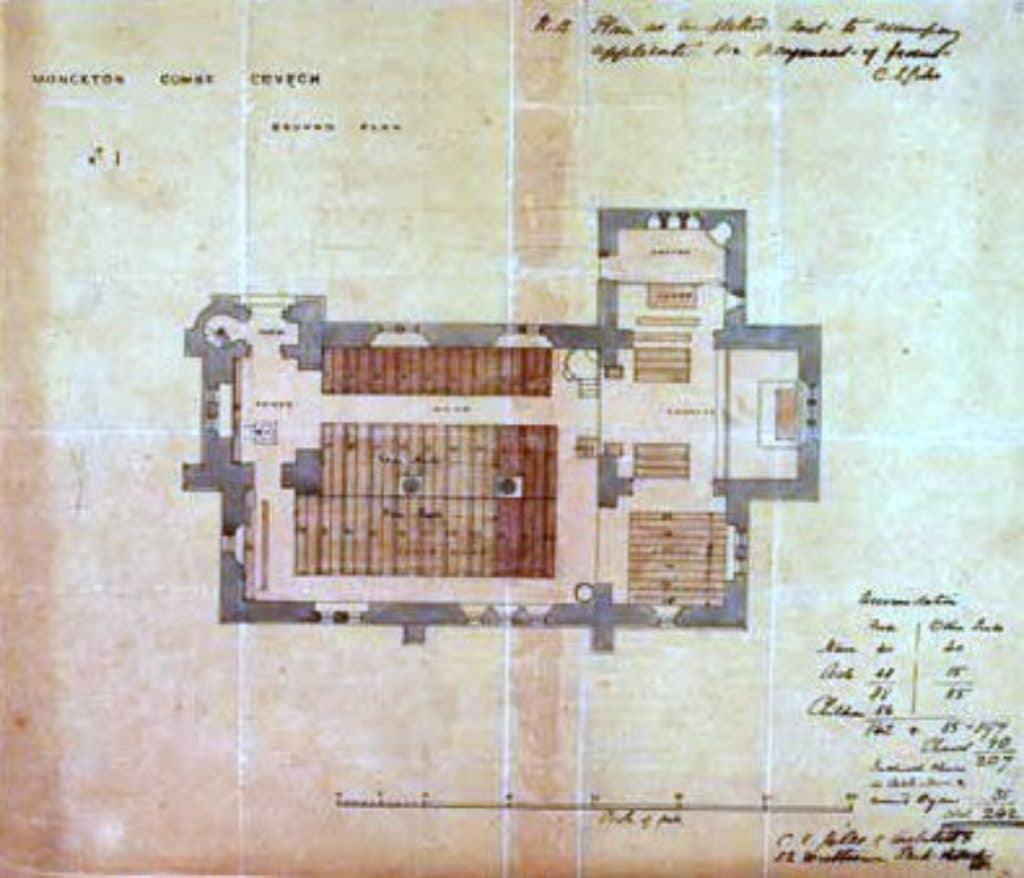
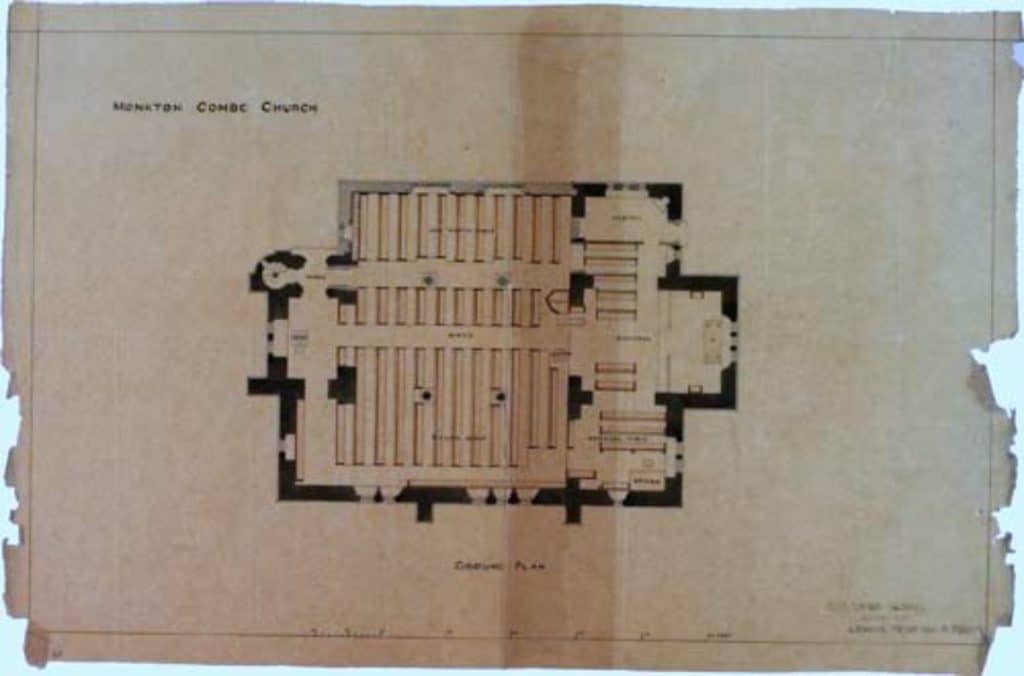
Vicars of Monkton Combe
Since 1863 the Vicars of Monkton Combe have been:
Rev Francis Pocock (1829 – 1919), 1863 – 1876
Francis Pocock went to Sierra Leone and was ordained there, becoming chaplain to the Bishop from 1855 – 1858.
During his time there he met Dr David Livingstone.
He left West Africa in 1858 because of bad health and he and his first wife were shipwrecked on their return when RMS Candace collide with Ida Elizabeth and sank.
The Pococks were amongst those rescued.
In 1861 he became curate of St James’s in Bath.
He became vicar of Monkton Combe in 1863 staying until 1877.
He set about rebuilding the church and in 1868 started Monkton Combe school.
Rev Alfred Grabham Gristock (1850 – 1893), 1876 – 1882
As well as being vicar he was vice principal of Monkton Combe school.
Rev David Lee Pitcairn (1848 – 1936), 1883 – 1914
David Lee Pitcairn was descended from the Fife Pitcairns[47]
"Henry Petcarne of that Ilk, seventh lord of Pitcarn, Strathearn, Pitcarn, Fife, and Innernethy, whose mother was Marion de Taillefer, and father, Henry, sixth laird of Pitcarn of that Ilk, living in 1420"
on his father’s side and from Arthur Guinness (1725 – 1803), who was his great grandfather, and Arthur Guinness II (1768 – 1855), who was his grandfather on his mother’s side.
He also taught at Monkton Combe school for 8 years, was a director of the school company for thirty two years and chairman for sixteen years.[48]
With Rev Alfred Richardson (1853 – 1925), vicar of Combe Down from 1902 – 1914, he wrote “An Historical Guide to Monkton Combe, Combe Down, and Claverton”.
Rev Sir Montagu Harry Proctor Beauchamp (1860 – 1939), 1914 – 1918
Rev Sir Montagu Harry Proctor Beauchamp was a British Protestant Christian missionary and the fourth son of Sir Thomas William Brograve Proctor-Beauchamp, 4th Baronet, and his wife the Hon. Catherine Esther, daughter of Granville Waldegrave, 2nd Baron Radstock.
Educated at Repton and Trinity College, Cambridge he was one of the Cambridge Seven: students from Cambridge University, who, in 1885, decided to become missionaries in China. He served with the China Inland Mission during the late Qing Dynasty in China. He was evacuated from China during the Boxer Rising in 1900, but was back in China again from 1902 to 1911.

On returning to England Beauchamp was ordained and had a few years parish work.
He was a chaplain to the forces in the First World War, service in Egypt and Greece, and as a senior chaplain in Murmansk in northern Russia. He succeeded in the Proctor-Beauchamp baronetcy in 1915 when his elder brother Horace was killed in the First World War.
His son 2nd Lieutenant Montagu Barclay Granville Proctor-Beauchamp (Granville Beauchamp) was killed at Gallipoli and is commemorated on the church war memorial.
Rev Percy Ewart Warrington (1889 – 1961), 1918 – 1961
Percy Ewart Warrington is a fascinating if not very sympathetic character. He was the elder of the two sons of Thomas Warrington, a farmer, and his wife Mary Jane, the daughter of William Wright, registrar of South Derbyshire. He was a committed, low church evangelical and understood the power of patronage.
Patronage is as ancient as the Church. The purchase of advowsons to ensure that a parish benefice became an evangelical stronghold, had begun in the 19th century and Warrington saw an opportunity to wield some power.
It was most often the local landowner who was responsible both for the building of a church and the upkeep of ministers. They usually retained the right to appoint the minister to the benefice, though with the consent of the ecclesiastical authorities. The right of appointment is called an advowson and the person or body who holds this right is the patron. A benefice generally included use of a house, i.e. a vicarage, parsonage or rectory, as well as the income from the glebe and tithes, which would provide for the living expenses of the incumbent, and the value of the advowson would thus vary according to how richly endowed the glebe had been.
By the early 20th century the advowson had negligible commercial value due to the Benefices Act 1898 but the patron could still exert moral influence on the parishioners through the teaching and sermons of the parish priest.
Warrington probably founded the Martyrs’ Memorial Trust in 1914, with the object of being a church patron by purchasing advowsons for the kind of clergy of whom he would approve. Who the original Trustees of Martyrs’ Memorial Trust were is not known and it is thought it arranged funding via appeals. In 1912 the Church of England Trust, had been established and in 1918 Warrington was appointed Honorary Secretary and he united the two bodies into one, called the Martyrs’ Memorial and Church of England Trust.
Within ten years the Martyrs’ Memorial and Church of England Trust had acquired about three hundred livings; founded public schools designed to propagate Warrington’s militant evangelicalism and attempted to found an Oxford College with the same principles.
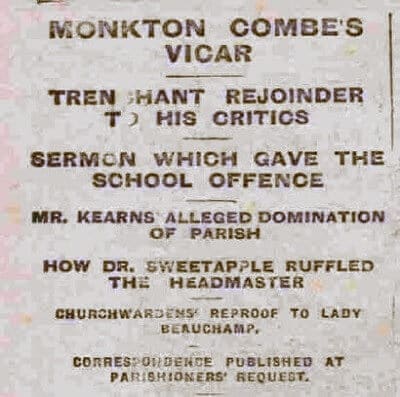
Also in 1918 the Oxford Churches Trust patron of the parish of Monkton Combe offered him the living there.
He soon caused a rift with Monkton Combe school. In 1919 he accused the boys of ‘heckling’ him as he preached, and demanded an apology. When the Headmaster, urged him to drop the matter, he said that he would call a Vestry meeting to discuss it. ‘It is quite evident that one of us is lying,’ he wrote to Kearns, himself a clergyman, and twice Warrington’s age.
He also used the idea of the village War Memorial pulpit, that had been agreed by the village, to preach against the school by accusing them of disrespect for the village dead and of wishing to dissociate themselves from the village memorial also saying that a boy put a button in the collection rather than cash.
The school stopped using the church and decided that ignoring Warrington and his insults of the headmaster, his wife, the staff and even the matron,was probably the best policy.
Warrington referred to his time at Monkton as ‘a living HELL’ [49] and informed the School:
"What you require ... is less unctuous cant and a little of the spirit of Christ. You couldn't find anything of the latter if you looked for it through a magnifying glass!"
This split with Monkton Combe school caused him to start buying schools as shown by an extraordinary letter [49] he wrote on 22 June 1923 to Rev J W Kearns, principal of Monkton Combe school:
"I write to tell you that had it been stated in the Bath Chronicle that Mr. Macnutt had been educated or connected with your 'School I myself should have promptly demanded an apology. For some time past I have been correcting reports from Lands End to John O'Groats that Mr. Macnutt was connected with your School. Parents have even gone so far as to decline to enter their boys at Canford School until they heard from me definitely that there was no connection and that Canford would not be run on similar lines to your own. At the same time don't you think you make yourself look ridiculously small in the eyes of other people when you exhibit such a spirit of jealousy against the Head Master of Canford School who has never done you the slightest injury in any shape or form. Your outburst is only further evidence of that jealousy of which we have seen so much. ... One had dared to hope that as you so recently hovered over the brink of Eternity you would have learned a better spirit but apparently it is not so, which I much regret to hear. If you would cast your mind back to 1919 you will perhaps recall I made a suggestion to rebuild your School. The Scheme which I helped Wilkinson to draw up appeared in the Bath Chronicle. On that occasion I told you I would help you to raise £50,000. From your subsequent conduct I always felt that you thought I could not do so. I will now tell you something which perhaps you will not care to know. I have purposely bought Canford Manor and Mr. Macnutt's old School and transferred it with its Head Master to Canford. This Scheme, with which no soul on earth has had anything to do but myself, has cost about £50,000 up to date, and within the next two years a further £20,000 will be spent. I have done this for no other reason than to prove beyond all further conclusion that when I say I can do a thing I do it and it is no idle boast. Every penny that I have spent at Canford your School could have had to the last coin. I very seriously doubt whether it may not be long years before any other man comes along and offers to do for you and your School what I offered to do when I came here. Canford School would never have existed had it not been for the treatment I received at the hands of your Monkton Combe School people. It has been a great impetus to work, and I have worked like the dickens, to prove to you and the crew you have around you, Powell and Co, that men with vision and enterprise can accomplish the seemingly impossible, whilst those who have neither can do nothing. I am greatly tickled to hear from your Son and others that you look upon my enterprises as being prompted with the notice of 'ruining* your School. How thoroughly typical is this statement of the Monkton Combe School mind. I can assure you I do not want your type of boy at any of my Schools, and, furthermore, I would point out that our Fees are half as much again as your own, so we are not likely to 'ruin' you just yet ... It is a most extraordinary thing to me that people who profess so much religion and stand before the world as Evangelical Christians of the Keswick Section, should be so furiously jealous of others and so intensely bitter. It is really a great puzzle to me how you Keswick people of the School can hold your Prayer Meetings and pose in CMS and other circles as you do. It takes some understanding I can assure you. I have witnessed so much of the spirit of you Monktonians that when appointing to any of the 50 livings in the Gift of our Trust nothing on earth would induce me to agree to the appointment of a clergyman who had been educated at Monkton Combe School, and the Head Masters of the Schools also know that the presence of a Monktonian on the Staff would be greatly offensive to me. From these sentiments, Mr. Head Master, you may best judge how 'the iron has entered my soul' and what I think of the 'spirit' of the Evangelical and Keswick Monkton Combe School. Perhaps it is well that I have seen 'the Monkton Spirit' and suffered the back stabbing etc., etc., etc., at the hands of Monktonians. It has proved the great impetus to work, and I do not think for one moment that Wrekin College would have been purchased by me had it not been for my determination to prove to you and others that I am capable of carrying out a task when I say I can do it. There would have been no Stowe School to-day if I had not begun with Wrekin, and I repeat there certainly would have been no Canford School but for the fact that I wished to give to another whom I deemed worthy of it, the £50,000 I promised to raise for you. I have cast my pearls before those who appreciate the gift, and do not turn again and rend you. These enterprises are the direct outcome of the attack which was made upon me in 1919. Perhaps history may have to record that good has come out of evil, but my earnest hope is that none of the three Schools in which I am interested will ever reflect the spirit of Monkton Combe 'School' ... That it may be known in years to come why I bought Canford School into being a copy of this letter will be carefully treasured in my Safe. If there is anything in this letter that your Solicitors can handle and you care to proceed I shall be very pleased to meet you, and them too."
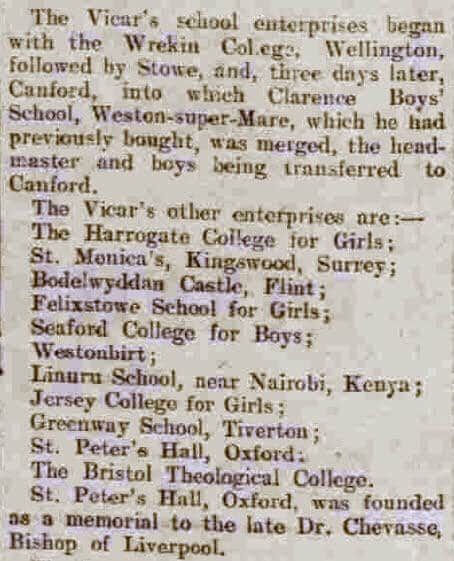
Interestingly for all his talk about money Warrington had purchased Wrekin with £80,000 borrowed from London Life Association Ltd with the balance of £30,000 to remain unpaid but subject to 7% annual interest.
He bought Stowe, which had been the home of the Dukes of Buckingham and Chandos, using the name of Wrekin College Limited as guarantor and only later informed the other directors what he had done.
In fact, he found each successive school by raising a mortgage on the last. He also arranged the financial years of the schools to end in different months, and put all the cash balances into the accounts of the school which was next to report. He also obtained second mortgages, increased bank overdrafts and used bills of exchange.
He was skilled at ‘appointing’ trustees and governors who had great wealth they would contribute to school projects but who were also ‘compliant’. [49]
For a while it was a profitable venture. For the year 1919-20, income for Wrekin was £31,795 and expenses £14,435. With £1,000 salary for the headmaster, this meant a profit of £16,360.
However, the profits of the schools were being used, against all the terms of the trust deeds, to purchase advowsons on an enormous scale.[49] It was illegal and financially disastrous as advowsons were a wasting asset as the Benefices Act 1898 (Amendment) Measure of 1923 phased out their sale, so that they could not be sold after two vacancies occurred after 14 July 1924.
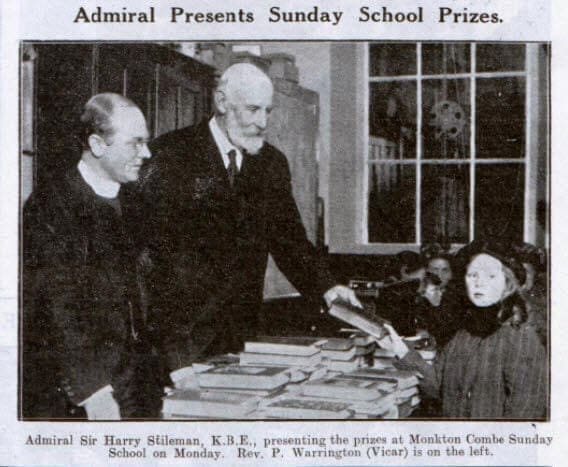
It ended badly as, in 1931, the Public Prosecutor was involved and in 1932 the largest creditor of the schools, the Legal and General Assurance Society, refused loans, until they obtained representation on the Council. By September 1933, with creditors becoming more vociferous, Law Union Insurance Company, London Life Association, Norwich Union and Legal and General met together and demanded Warrington’s resignation from all his positions.
To save the schools, Legal and General provided a mortgage, which was not repaid until 1980, and the influence of the Martyrs’ Trust was restricted to nominate only one sixth of the school governors. Stowe, Wrekin, Canford (which started on Combe Down as Combe Down School), Harrogate, Westonbirt, Lowther and Felixstowe survived to become Allied Schools.
In 1936 Christopher Maude Chavasse, OBE, MC, TD (1884 – 1962), who became Bishop of Rochester in 1940 and had been treated appallingly by Warrington over the building of St Peter’s College, Oxford expressed his views of the way he had been treated in a letter to the Bishop of Manchester, Edmund Arbuthnott Knox (1847 – 1937):[49]
"... the devious and inexplicable processes of the Martyrs Memorial Trust ... the suspicion and odium that the Martyrs Memorial Trust have earned ... For the past two years I have been obstructed and beset by a whole mass of shady work, such as secret documents, and deeds unlawfully withheld, and so forth. It was like living in a Dicken's novel; and I had not known that such practices were possible even among unchristian laymen. I had never come across what the Bishop of Durham described as the 'Protestant underworld' till I touched the Martyrs Memorial Trust; and I still feel defiled, even though, thank God, we are now quit of them..."
The debacle of the schools, together with the understanding that Warrington via his control of the Martyrs Memorial Trust had cheated and ignored the wishes of donors such as Mrs. Ella Rowcroft. She was a wealthy and philanthropic widow who was descended from the Wills family, the tobacco importers and cigarette manufacturers and had given at least £69,000 (worth about £12,840,000.00 now) on the condition that Martyrs Memorial Trust purchase advowsons and only introduce clergy that followed certain teachings:[49]
"Deed of Covenant, made on the 22 November 1930 between Mrs. Rowcroft and the Trustees of the MMT WHEREAS the Donor at various times has made gifts of certain sums of money to the Trustees amounting in the aggregate to the sum of £35,000 for the purpose of acquiring the several advowsons mentioned and referred to in the Schedule hereto and has also given to the Trustees the sum of £10,000 for the purpose of establishing a Hall within the University of Oxford known as St.Peter's Hall and the further sum of £15,000 for the benefit of or for the purposes of the Jersey Ladies College, and the further sum of £9,500 for the benefit of or for the purposes of Felixstowe Ladies School AND WHEREAS the Donor made such gifts on the condition that the Trustees should enter into the covenants hereinafter contained NOW THIS DEED WITNESSETH that the Trustees hereby covenant with the Donor as follows: 1. The Trustees will present or cause to be presented to the said Advowsons mentioned or referred to in the Schedule hereto only such Clergymen who subscribe to the scriptural basis of a Society known as the Bible Churchmen's Missionary Society and who do not subscribe to any other Society having a scriptural basis other than the present Scriptural basis of the Bible Churchmen's Missionary Society and be believers in and teachers of the plain truths and doctrines of the Bible as taught in the Church of England in the past and free from the new and questionable Modernist Teachings and from Anglo-Catholic teachings and the teachings of the Roman Catholic Church. 2. The religious teaching given at the Jersey Ladies College and at Felixstowe Ladies School, and at any other School under the direct control of the Martyrs' Memorial and Church of England Trust shall be in accordance with the scriptural basis of the Society known as the Bible Churchmen's Missionary Society, and shall be free from the new and questionable Modernist teachings, and from Anglo-Catholic teachings and the teachings of the Roman Catholic Church ..."
Some of the led advowsons mentioned in the schedule had not been purchased and the terms of appointment led to a further outcry and which was partially responsible for the Benefices (Purchase of Rights of Patronage) Measure, 1933 to stop the sale of advowsons altogether.
Speaking in the House of Lords about the measure on 2 March 1933, the Archbishop of Canterbury, William Cosmo Gordon Lang, 1st Baron Lang of Lambeth, GCVO, PC (1864 – 1945) said:
"...What are called party trusts, my Lords, have already secured, I think, an undesirable amount of patronage in the Church of England. Rather more than 1,000 benefices are now within the control of these party trusts. They represent both of the main parties in the Church of England, though preponderantly one....Quite recently one particular individual, who appears to have large financial resources, has acquired the patronage, for himself or for trusts which he controls, of no fewer than 203 benefices in the Church of England. These undesirable transfers have been rendered more easy by the complete secrecy with which for a long time they could be carried out..."
Percy Warrington lost all his positions apart from the living at Monkton Combe and ‘retired’ to Monkton Combe until he died.
After the Second World War, he concentrated on improving housing conditions, and became fully involved in work for the aged. He founded two homes: Claremont House, Corsham, Wiltshire, and Waterhouse at Monkton Combe itself.
He was certainly capable of kindness to individuals and his obituary has the headline: “Vicar who was well loved”.
Even with all the problems he created he left behind a legacy of the Allied Schools, St Peter’s College, Oxford and Trinity College, Bristol.
One small mystery remains. He left an estate of £47,121 12s 1d in 1961 which is worth about £2,197,000.00 now – how was that acquired on a ‘parsons salary’?
Since 1961 the vicars of Combe Down have also been vicars of Monkton Combe.
N. B. You can find out who is buried at St. Michael and All Angels Church on the BRO Monkton Combe burials page.
